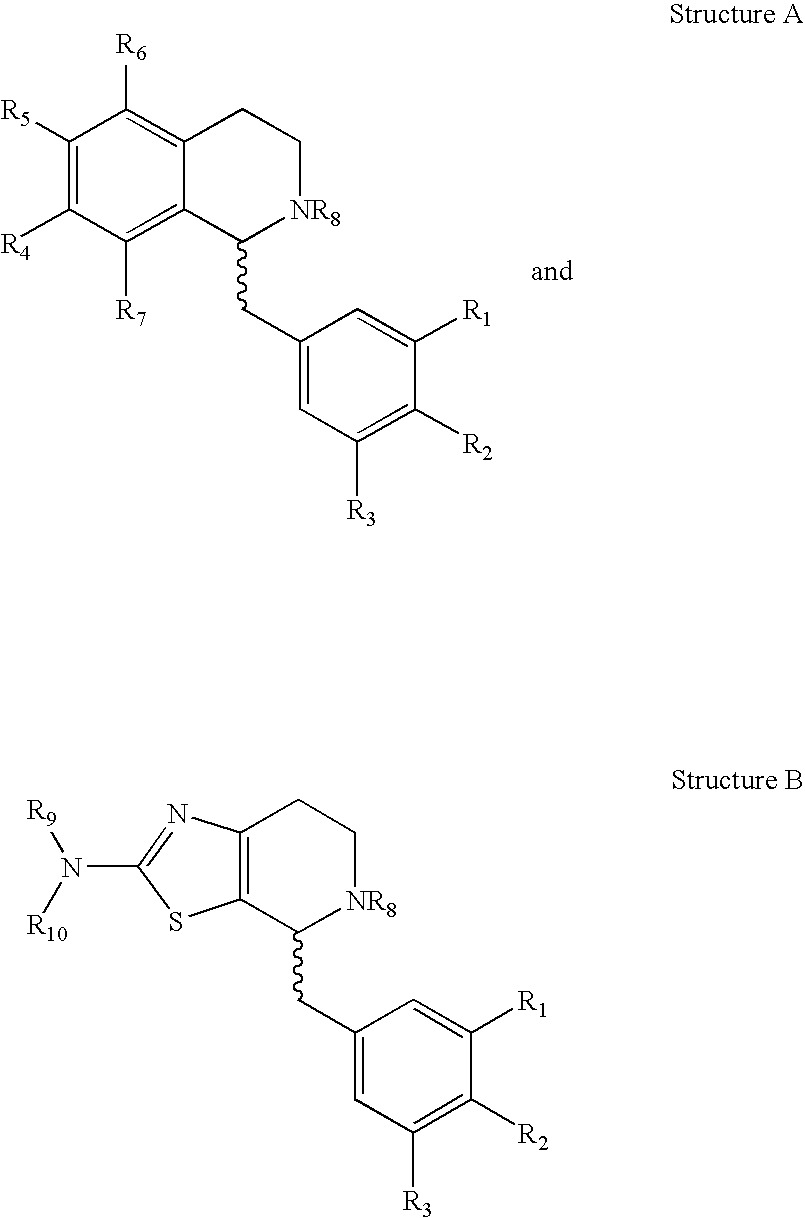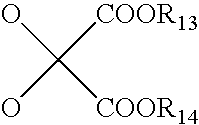Beta3-Adrenoreceptor agonists, agonist compositions and methods of using
a technology of beta3-adrenoreceptor and agonist composition, applied in the direction of drug composition, biocide, metabolic disorder, etc., can solve the problems of indifferent success at best, increased costs attributable to overweight and obesity, and inability to meet the needs of people with obesity, etc., to achieve adequate intake of vitamins and minerals, accelerate excretion, and balanced diet
- Summary
- Abstract
- Description
- Claims
- Application Information
AI Technical Summary
Benefits of technology
Problems solved by technology
Method used
Image
Examples
example 1
N-(3,4-dimethoxyphenethyl)-4-nitrophenylacetamide
[0167] 43
[0168] A solution of 3,4-dimethoxyphenethylamine (5.0 g, 27.6 mmol) and 4-nitrophenylacetic acid (7.5 g, 41.4 mmol) in toluene (150 mL) was heated at reflux for 72 h in a flask equipped with a Dean-Stark trap under an argon atmosphere. The solvent was evaporated in vacuo and the residue was taken up in CH.sub.2Cl.sub.2 (200 mL). The solution was washed consecutively with H.sub.2O (100 mL), 10% HCl (2.times.100 mL), H.sub.2O (2.times.100 mL), 10% NaHCO.sub.3 (2.times.200 mL), H.sub.2O (2.times.100 mL) and dried over MgSO.sub.4. The solvent was evaporated and the crude solid was recrystallized from EtOAc to give 5.49 g (58%) of the product as ivory colored needles: mp 119-121.degree. C. (lit..sup.22 130-132.degree. C., ethanol-isopropanol); .sup.1H NMR (CDCl.sub.3) .delta.8.16 (d, J=8.8 Hz, 2H, ArH), 7.37 (d, J=8.8 Hz, 2H, ArH), 6.73 (d, J=8.1 Hz,1H, ArH), 6.65 (d, J=1.9 Hz, 1H, ArH), 6.60 (dd, J=8.1 & 1.9 Hz, 1H, ArH), 5.40 (m...
example 2
N-(3,4-dim thoxyphenethyl)-3,5-bis-trifluoromethylphenylacetamide
[0169] 44
[0170] A solution of 3,4-dimethoxyphenethylamine (2.72 g, 15 mmol) and 3,5-bis-trifluoromethylphenylacetic acid (2.72 g, 10 mmol) in toluene (50 mL) was heated at reflux for 80 h in a flask equipped with a Dean-Stark trap. The solvent was evaporated in vacuo and the residue was taken up in CH.sub.2Cl.sub.2. The solution was washed consecutively with 0.1 N HCl (30 mL), H.sub.2O (50 mL), 0.1 N NaOH (30 mL), H.sub.2O (50 mL) and dried over MgSO.sub.4. The solvent was evaporated and the crude solid was recrystallized from toluene to give 3.44 g (79%) of the product as white needles: mp 127-128.degree. C.; .sup.1H NMR (CDCl.sub.3) .delta.7.79 (s, 1H, ArH), 7.72 (s, 2H, ArH), 6.75 (d, J=8.1 Hz, 1H, ArH), 6.67 (d, J=1.9 Hz, 1H, ArH), 6.61 (dd, J=8.1 & 1.9 Hz, 1H, ArH), 5.55 (m, 1H, NH), 3.85 (s, 3H, OMe), 3.84 (s, 3H, OMe), 3.58 (s, 2H, CH.sub.2), 3.52 (q, J=6.9 Hz, 2H, CH.sub.2N), 2.75 (t, J=6.9 Hz, CH.sub.2); .sup....
example 3
6,7-Dimethoxy-1-(4-nitrobenzyl)-1,2,3,4-tetrahydroisoquinoline
[0171] 45
[0172] A mixture of 5a (8.0 g, 23.2 mmol) and POCl.sub.3 (15.6 mL, 167.4 mmol) in dry MeCN (160 mL) was heated at reflux for 4 hours. The solvent was evaporated in vacuo to give a glassy residue which was taken up in methanol (250 mL) and evaporated to dryness three times until the residue was a solid. The solid residue was dissolved in MeOH (250 mL) then cooled in an ice bath. Excess NaBH.sub.4 (17.56 g, 167.4 mmol) was carefully added in portions. The mixture was stirred at room temperature overnight. The solvent was removed in vacuo and the solid residue was partitioned in CH.sub.2Cl.sub.2 (250 mL) and H.sub.2O (150 mL). The layers were separated and the H.sub.2O layer was extracted with CH.sub.2Cl.sub.2 (100 mL). The combined organic fraction was washed successively with H.sub.2O (2.times.50 mL), 2N NaOH (2.times.50 mL), H.sub.2O (50 mL), and dried with Na.sub.2SO.sub.4. The solvent was evaporated to give a r...
PUM
| Property | Measurement | Unit |
|---|---|---|
| temperature | aaaaa | aaaaa |
| temperature | aaaaa | aaaaa |
| temperature | aaaaa | aaaaa |
Abstract
Description
Claims
Application Information
 Login to View More
Login to View More - R&D
- Intellectual Property
- Life Sciences
- Materials
- Tech Scout
- Unparalleled Data Quality
- Higher Quality Content
- 60% Fewer Hallucinations
Browse by: Latest US Patents, China's latest patents, Technical Efficacy Thesaurus, Application Domain, Technology Topic, Popular Technical Reports.
© 2025 PatSnap. All rights reserved.Legal|Privacy policy|Modern Slavery Act Transparency Statement|Sitemap|About US| Contact US: help@patsnap.com



